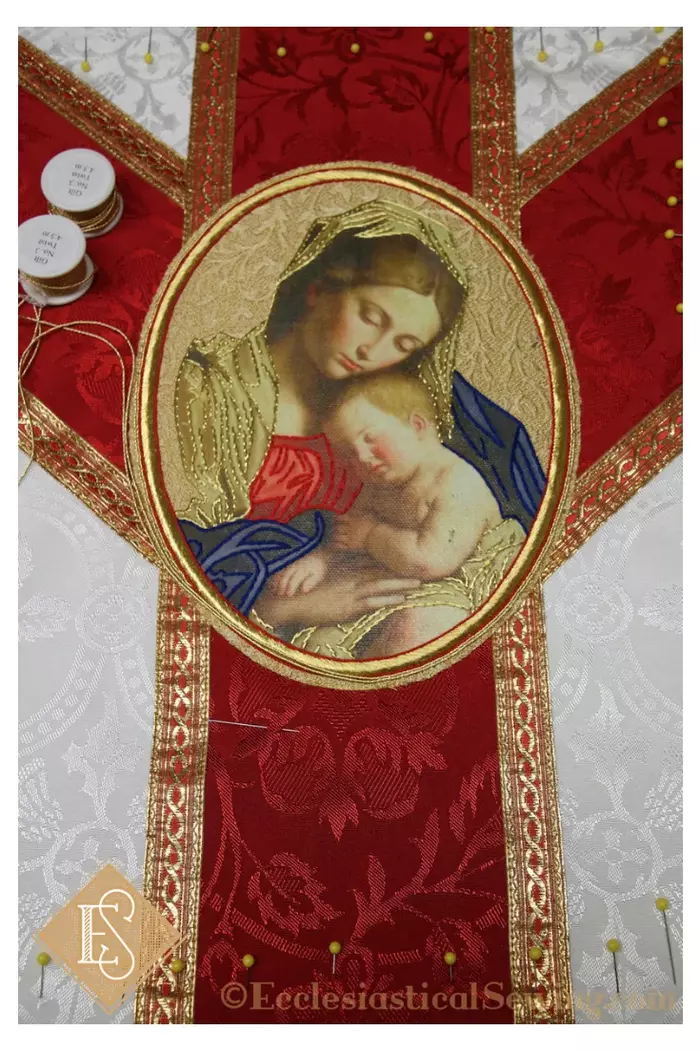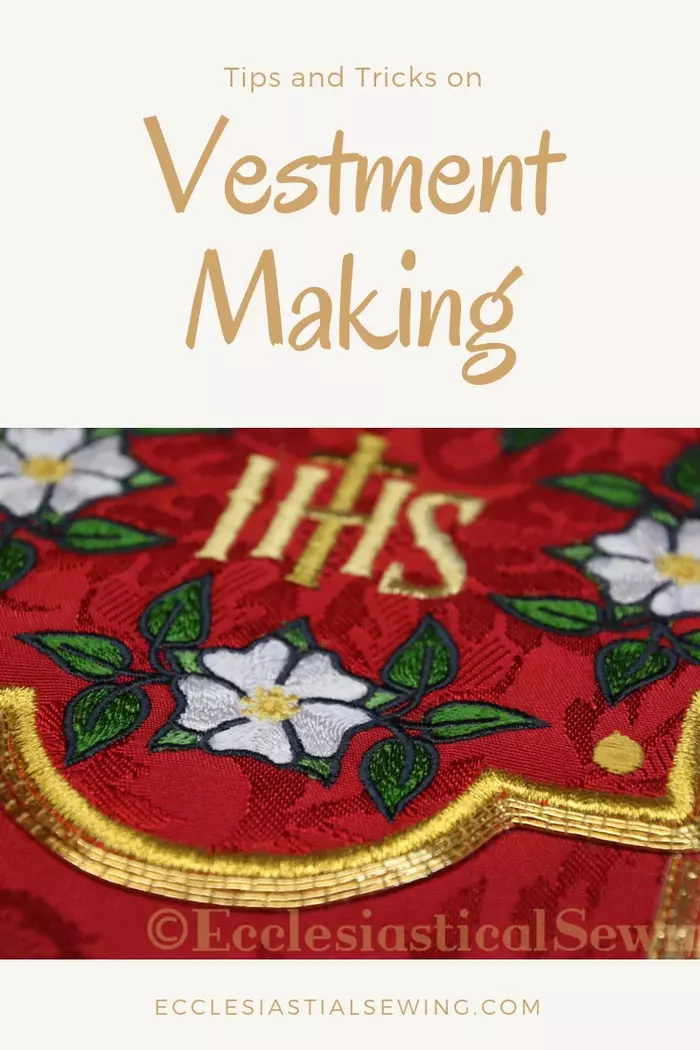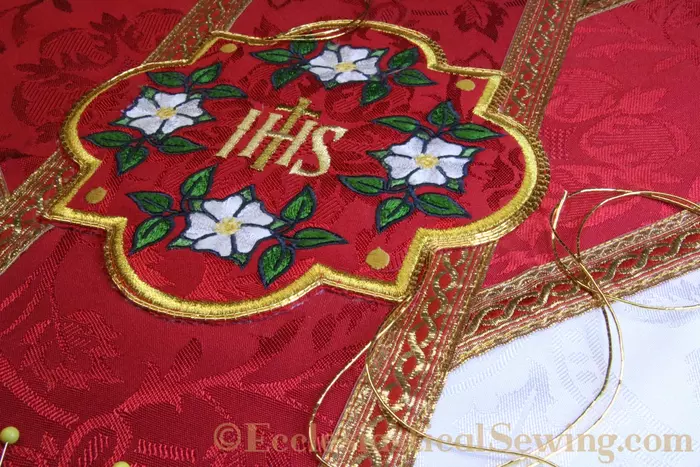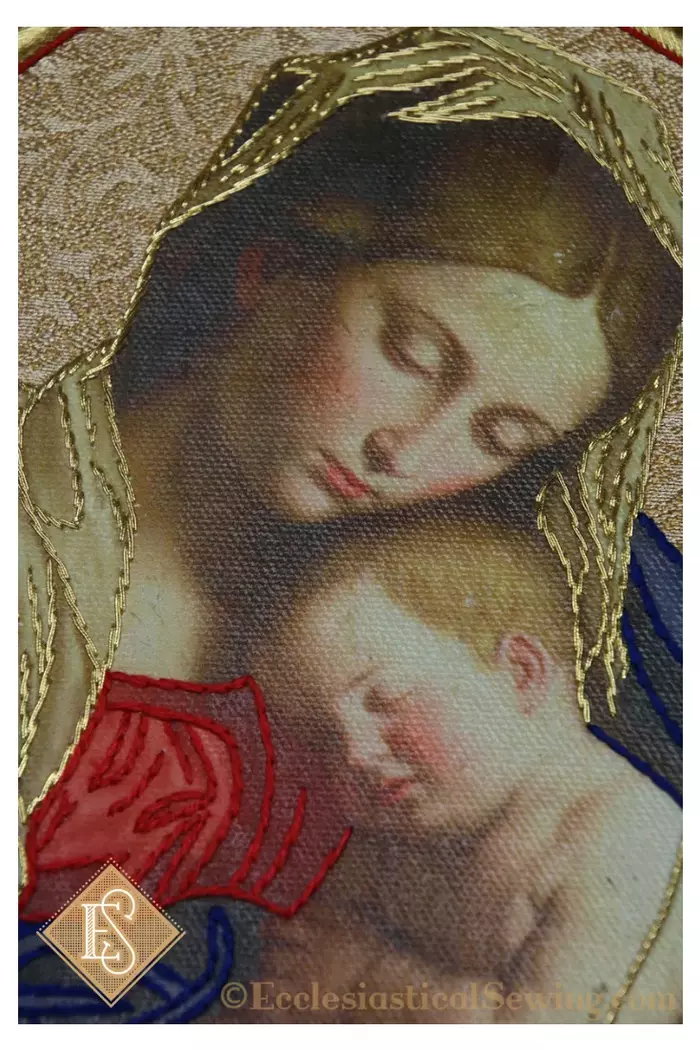The Christmas Rose Legend & Symbolism
The Christmas Rose Legend & Symbolism
The Christmas Rose Vestment set has been a personal favorite of mine. There are several things about the set that keep drawing me back to it. The first is the theme of the set – Christmas. There is no mistaking this set is intended for use at Christmas.
The second is the color selections of white, red, and gold, all of which are used in proportions. White is the dominant color. Red is the secondary color and gold is the accent color. All of the colors are used proportionally to create a sense of balance and beauty.
The next part of the design that attracts my attention is the design. There a just a few designs for the set. It is kept simple on purpose because the main designs of the chasuble tell the story.
The front of the chasuble is adorned with the Messianic Rose worked in a quatrefoil design with the IHS monogram. The Messianic rose is referred to by the prophet Isaiah:
Isaiah 35:1,2 The wilderness and the wasteland shall be glad for them, and the desert shall rejoice and blossom as the rose
Value of the Madonna and Child Embroidery
The use of a rose has been common sense since the 13th Century and is frequently used in Gothic wood carving as well as in hand embroidery. The rose is also often seen in heraldry. The Messianic rose can take on many forms. The form used in this chasuble and church vestment set comes from a design in my private collection. The design is part of a collection of vintage embroidery designs that date back to the late 1870s. I have taken the original design and created an entire collection of machine embroidery designs, including the above design, which is part of Ecclesiastical Sewing’s Christmas Rose Collection. Several of the designs are available as machine embroidery designs for digital downloads.
The back of the chasuble is adorned with the Madonna and Child Emblem. This is a hand-painted design that is embellished with silk and gold embroidery. The embroidery is rather stiff with paper backing. One must use care when working with these emblems to ensure that the paint surface isn’t scratched.
The Madonna and Child embroidery is an oval shape that is hand-couched to the vestment after the orphreys have been stitched in place. The design is made up of several “components” that are placed together for the final design. The first is the hand-painted image on canvas ground. It is difficult to tell exactly how this is done – the original design was most likely hand-painted, but for these, the designs are most likely done using some sort of printing process. The canvas image is placed on a cloth of gold and then accented with gold and silk threads. The edge is finished with more gold embroidery and paper backing is added to finish the design. There is a small 1/8″ edge left on the design to apply goldwork threads for hand couching.
Qualities of Cloister Brocade and St. Aidan Brocade Liturgical Fabric
The set is made using the white Cloister Brocade and the red St. Aidan Brocade is the accent used for orphrey bands. Both religious fabrics are priced as introductory brocades. Yet, don’t let their moderate price be a deterrent. Both fabrics pack a lot of value for the dollar with both qualities of design, selection of yarns for weaving, and finished weight and appearance of the fabric. The white Cloister is a “dazzling” white that simply shines with beauty. It is pristine.
Cloister Brocade is a liturgical fabric that has a lovely, soft hand that falls in delicate folds. Yet it has enough body and weight in its weave to work well for tailored items such as burses and altar hangings. St. Aidan and Cloister share the same yarns which means they have identical hands. The fabrics are piece dyed rather than yarn dyed which means the fabric is woven, and then the colors are added to the fabric.
Liturgical Vestment at Ecclesiastical Sewing
Now that we have discussed the background information regarding the designs and fabrics, let’s move on with the project. And with a set like this, the largest piece in the project is, of course, the chasuble. This is the most visible piece and the piece that will receive the embellishment of hand couching with goldwork threads.
At Ecclesiastical Sewing, we carry a large number of chasuble patterns and hope to add to the number shortly with several more styles of the Fiddleback chasubles. The chasuble used for the Christmas Rose Vestment set is our Gothic Chasuble pattern. The pattern came from a vintage church vestment that I was able to trace during my travels. The tracing was given to my pattern maker and she properly cleaned up the pattern, sized the neckline, added the “Y” orphrey bands, and gave us a great pattern to use to create Gothic Chasubles.
The construction is fairly simple – there is a front pattern piece, a back pattern piece, a column piece for the front and back, and “Y” arms for both the front and back. The pattern also uses neckline-facing pieces. Now, I know many of you take existing garments and trace patterns from those to create church vestments. And that is fine – to a point. The pattern traced off the original vestment determines the quality of the finished vestment.
Pattern Making in Church Vestments
That is worth repeating – the finished vestment will only be as good as the job that was done tracing the pattern from the original vestment. And therein often lies the problem. Many of us have sewn for years, but not everyone has had the training in pattern making. When a pattern is traced off an original vestment, one really needs to take care to ensure that seams are trued, curves are cut correctly and have the proper slope, necklines have the proper width for the opening, being neither too large, nor too small, and a host of other things a mile long. The intent here is not to discourage those who wish to create their own patterns, but rather, to ensure that thought and care are given to the skill of the creator. Skimping on the fee to purchase a pattern when sewing fabric that runs $80 per yard can spell disaster. Spend the money when in doubt, whether it is my pattern, or someone else, but start with a good pattern. And do beware. I have purchased church vestment patterns over the years from several sources and have been disappointed with the purchase. I know that disappointment and that is why our patterns are created by a professional pattern maker. While I have been trained to make patterns, I still use a professional to ensure that the patterns we offer are properly created. Our pattern maker has the proper tools, equipment, and pattern-making programs, along with the sizing models and tables to create great finished church vestment patterns.
I hope that I can help you make these beautiful and important pieces for your church. This is an important art and tradition that ought to be passed on to future generations. For those of us who have talents to create, spending our time and talents on the church is highly worthwhile.
Have a blessed Christmas Eve and Christmas Day! From all of us at Ecclesiastical Sewing, may God bless and keep you.
-Soli Deo Gloria-
Messianic Christmas Rose with Crown Liturgical Machine Embroidery Design
Rose Chasuble and Stole Vestments for Advent and Lent
The Christmas Rose
Symbolism in the Church: The Cross
Pelican as a Symbol of Christianity
Design Options for Christmas Set











 RSS - Posts
RSS - Posts
beautiful.